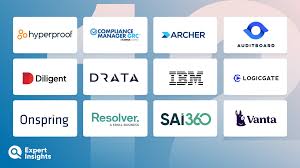The Importance of Governance, Risk, and Compliance (GRC) Systems in Today’s Business Environment
In today’s complex and rapidly changing business landscape, organisations face a myriad of challenges when it comes to managing governance, risk, and compliance (GRC). To address these challenges effectively, many businesses are turning to GRC systems as a comprehensive solution for ensuring regulatory compliance, managing risks, and maintaining good governance practices.
What Are GRC Systems?
GRC systems are integrated platforms that help organisations streamline their processes for managing governance, risk, and compliance requirements. These systems provide a centralised framework for monitoring and addressing various aspects of GRC across the entire organisation. By consolidating data and automating workflows, GRC systems enable businesses to proactively identify risks, ensure adherence to regulations, and improve decision-making processes.
The Benefits of Implementing GRC Systems
There are several key benefits to implementing GRC systems within an organisation:
- Enhanced Compliance: GRC systems help businesses stay compliant with industry regulations and standards by providing tools for tracking regulatory changes, assessing compliance levels, and generating reports.
- Risk Mitigation: By centralising risk management processes, GRC systems enable organisations to identify potential risks early on, assess their impact, and implement mitigation strategies to reduce exposure.
- Improved Governance: GRC systems promote good governance practices by establishing clear accountability structures, defining roles and responsibilities, and fostering transparency in decision-making processes.
- Efficiency and Cost Savings: Automating GRC-related tasks through a unified system can help streamline operations, reduce manual errors, and lower costs associated with compliance management.
Challenges in Implementing GRC Systems
While the benefits of GRC systems are clear, implementing such a system can present its own set of challenges. Some common obstacles include:
- Data Integration: Consolidating data from disparate sources into a single platform can be complex and time-consuming.
- User Adoption: Ensuring that employees understand how to use the system effectively and comply with its requirements is crucial for successful implementation.
- Customisation Needs: Different organisations have unique GRC requirements that may necessitate customising the system to align with specific business processes.
The Future of GRC Systems
As technology continues to evolve and regulatory landscapes become more stringent, the role of GRC systems in modern businesses is set to expand. Future advancements in artificial intelligence (AI), machine learning (ML), and automation will likely enhance the capabilities of GRC systems further by enabling predictive analytics, real-time monitoring of risks, and adaptive compliance strategies.
In conclusion, implementing a robust GRC system is essential for organisations looking to navigate the complexities of governance, risk management, and compliance effectively. By leveraging the power of technology through integrated platforms like GRC systems, businesses can proactively address challenges while driving sustainable growth in today’s competitive environment.
Understanding the Core Elements and Key Components of Governance, Risk, and Compliance (GRC) Systems
- What are the pillars of Governance, Risk, and Compliance?
- What is risk in GRC?
- What are the components of GRC?
- What are the three parts of Governance, Risk, and Compliance?
What are the pillars of Governance, Risk, and Compliance?
The pillars of Governance, Risk, and Compliance (GRC) form the foundational framework that underpins effective management of organisational processes. Governance represents the establishment of clear structures and accountability mechanisms to guide decision-making and ensure ethical conduct. Risk management focuses on identifying, assessing, and mitigating potential threats that could impact business objectives. Compliance involves adhering to relevant laws, regulations, and internal policies to maintain legal and ethical standards. Together, these pillars work in harmony to promote transparency, accountability, and resilience within an organisation’s GRC framework.
What is risk in GRC?
Risk in Governance, Risk, and Compliance (GRC) systems refers to the potential for adverse outcomes or events that could impact an organisation’s ability to achieve its objectives. In the context of GRC, risk encompasses various factors, including financial risks, operational risks, compliance risks, and strategic risks. Identifying and assessing risks is crucial for effective risk management within GRC frameworks, as it allows organisations to prioritise mitigation efforts and allocate resources appropriately. By understanding the nature of risk in GRC systems and implementing proactive measures to address potential threats, businesses can enhance their resilience and safeguard their operations against uncertainties in today’s dynamic business environment.
What are the components of GRC?
The components of Governance, Risk, and Compliance (GRC) systems encompass a holistic approach to managing the interconnected aspects of governance, risk management, and compliance within an organisation. These components typically include governance structures and processes that define roles, responsibilities, and decision-making frameworks; risk management tools and methodologies for identifying, assessing, and mitigating risks across the business; and compliance mechanisms to ensure adherence to regulatory requirements and industry standards. By integrating these key components into a unified system, businesses can enhance transparency, accountability, and efficiency in their GRC practices while fostering a culture of proactive risk mitigation and regulatory compliance.
What are the three parts of Governance, Risk, and Compliance?
Governance, Risk, and Compliance (GRC) encompass three essential components that are crucial for effective management within an organisation. Firstly, governance involves establishing clear structures, processes, and responsibilities to ensure accountability and transparency in decision-making. Secondly, risk management focuses on identifying, assessing, and mitigating potential risks that could impact the organisation’s objectives. Finally, compliance entails adhering to relevant laws, regulations, and internal policies to maintain ethical standards and avoid legal repercussions. Together, these three parts of GRC work in harmony to promote good governance practices, mitigate risks proactively, and uphold compliance standards within the organisation.

